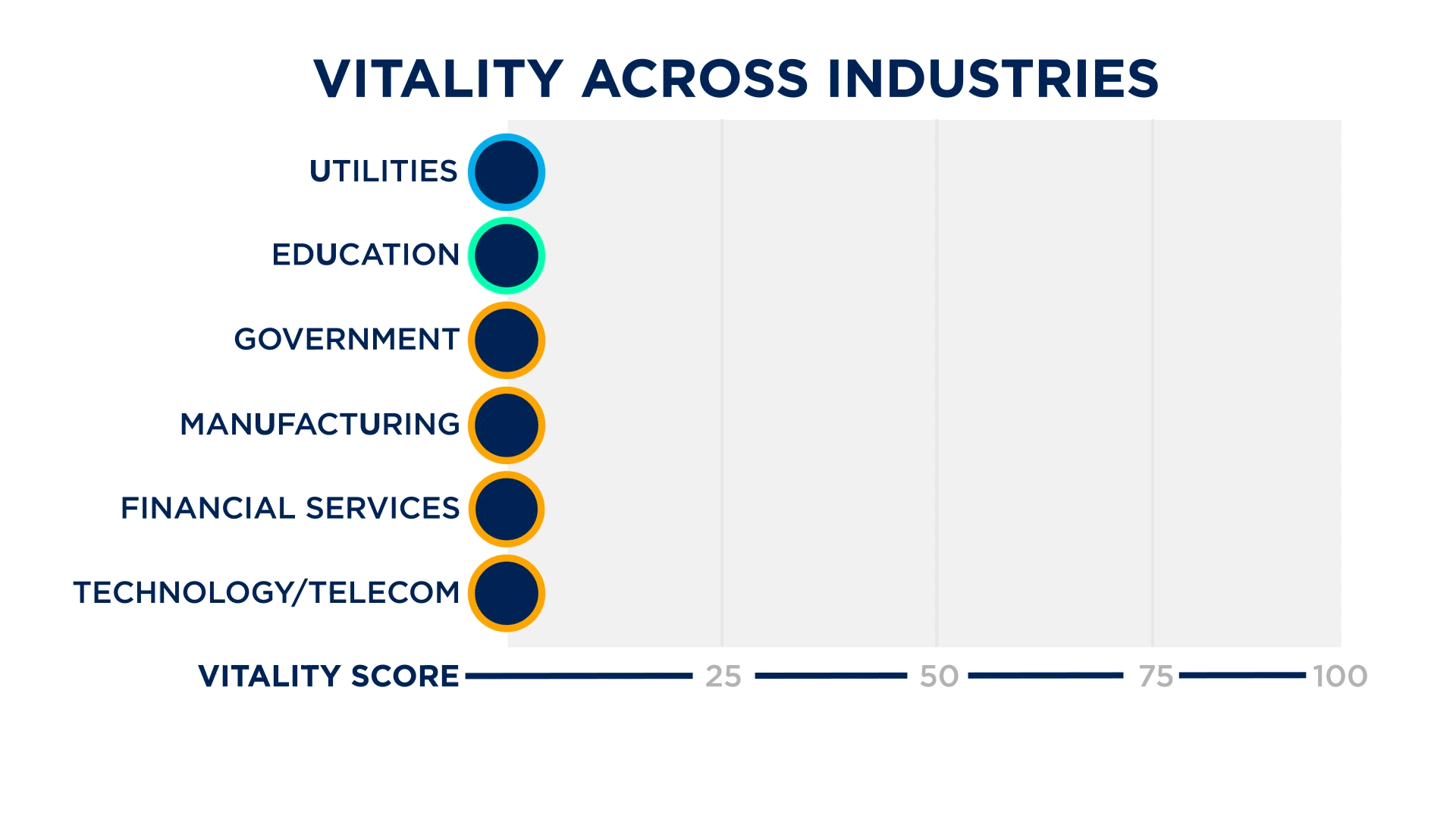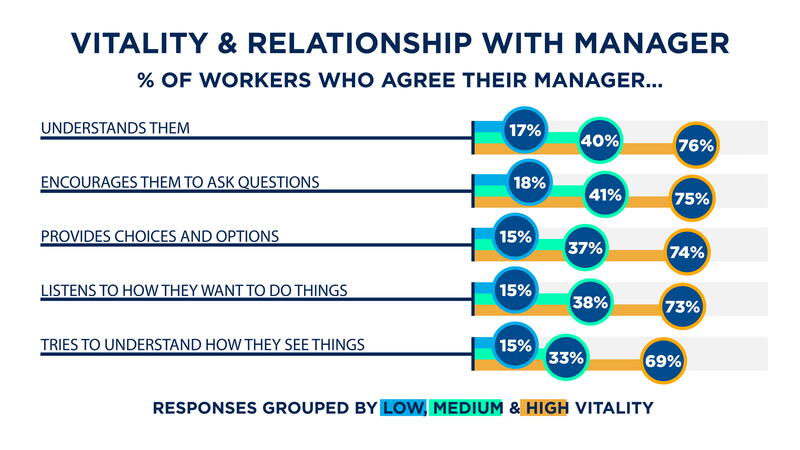
Cigna Healthcare SM has sponsored and provided editorial input on this article.
Higher vitality is linked to a more motivated, connected, and productive workforce. Yet many employed adults are operating with low levels of vitality, jeopardizing their ability to engage and contribute, and increasing the likelihood of poor work quality, employee absenteeism, and turnover.
By better understanding vitality and the factors that impact it, employers can help fuel a healthier workforce and drive business and economic growth. The Evernorth Vitality Index benchmark study found that U.S. adults who work for pay (“workers”) have higher levels of vitality than those who are unemployed. The research indicates a number of potential reasons, including access to health benefits, care, and services. The vast majority (95%) of workers with high vitality say they have health insurance, and 51% indicate they obtain it through their employer. In addition, 77% of workers have a primary care provider, and 69% had an annual physical within the past year. Overall, people who are employed are more likely to consider themselves in excellent health than people who are not employed (20% vs. 9%), with significantly more workers reporting excellent mental health (23% vs. 10%) and excellent physical health (17% vs. 8%). The research indicates workers are more likely to eat well (44%), exercise (78%), and have better sleep quality (15%). They are also less likely to experience chronic pain (25% vs. 46%).

Sixty-four percent of workers report having a chronic condition such as high blood pressure (21%), high cholesterol (19%), depression or anxiety (19%), asthma (13%), diabetes (11%), or arthritis (11%), and 22% of workers have at least two chronic conditions. However, those with chronic conditions believe more strongly than non-workers with chronic conditions that they can manage their health (48% vs. 28%). Among those who are not employed, 73% reported having at least one chronic condition, and 25% strongly agree they have “good medical care” for their health condition. This is in contrast to the 28% of workers with at least one chronic condition who feel the same. People who are employed often demonstrate a level of competence in other areas of their life as well. They are significantly more likely to feel confident in their ability to complete difficult tasks compared with those who are not employed (53% vs. 41%). More workers than non-workers say they are able to adapt when changes occur and tend to bounce back after illness, injury or other hardships.

Gig Workers
Autonomy and choice drive vitality levels for workers, including independent contractors and gig workers. The majority of these workers have medium vitality levels, but there are distinctions between high and low levels. The top two age groups of gig workers are 18 to 34 (38%) and 45 to 64 (33%), but gig workers with low or high vitality levels are more likely to be 35 to 44 years old. They also are more likely to work multiple jobs and to be seeking other work. Those with low vitality are likely to have trouble finding a job working for an employer or say they need to develop marketable skills. In contrast, high-vitality gig workers are more likely to have chosen their path because it lets them decide how, when, and where to work. They earn more than their low-vitality counterparts and have greater confidence in their ability to keep up with their expenses. They also are more likely to work more than 30 hours a week, while low-vitality gig workers tend to work less.
Work Culture and Vitality
Vitality also helps quantify the relationship between work culture and employee wellness. We learned that workers tend to have higher vitality levels when they feel their employers prioritize their wellness, enable them to maintain strong work-life balance, and communicate clearly. Workers with high vitality are more likely to agree that their employer provides adequate opportunities to care for personal health (71%) and shows focus on wellness in actions and communications (62%). While many workers feel supported by their employers, sizable minorities do not, and 29% of all workers say that work causes their personal life to suffer.

Internal communication is key in demonstrating employers’ priorities and enabling a sense of autonomy for employees. Workers with high vitality are distinguished by a near-universal sense that they are kept informed about what is going on in the company (93% vs. 52% of low-vitality workers). Interestingly, we found that many workers with high vitality are at a transitional period. They are more likely to be in the 35 to 44 age bracket, representing a large share of working parents and professionals who may be experiencing positive life shifts, such as engagements, pregnancy, and new parenthood. Their families and relationships lend themselves to positive social well-being; we found that 92% of high-vitality workers make time for relationships.
This group also illustrates that thriving at work is possible within a supportive work culture, with 72% saying that their work environment enables their family and personal commitments, compared with just 13% of low-vitality workers.
Work Relationships and Vitality
While work culture is critical for fostering wellness and boosting vitality, personal relationships at work also play an important role. Employed people with high vitality overwhelmingly “feel connected with people” at work (79%) compared to 36% of medium-vitality workers and 12% of low-vitality workers.
In addition, those with high vitality report strong relationships with their managers and are more likely to feel they can easily express their opinions or feelings about their job conditions, agree that their manager tries to understand how they see things, and feel encouraged to ask questions.

Stress and Vitality
Among all workers, 25% often feel stress because of work and an additional 42% report that they sometimes feel stress from work. Digging deeper reveals that 20% of employed people with high vitality feel stress often or very often because of their work, as do 39% of low-vitality workers. However, employees with high vitality are less likely to miss work due to illness or stress. Only one in four missed a day in the last month due to stress, compared to 35% of low-vitality workers, while a third (32%) with high vitality missed a day of work due to illness in the past month, compared to nearly half (47%) of low-vitality workers.
Interestingly, however, high-vitality workers are as likely, or more likely, to feel stress as their low-vitality counterparts in several areas:
- 24% vs. 17% report they often or very often have unreasonable deadlines.
- 28% vs. 29% say they often or very often have too much work.
Vitality Differs Across Industries
Industries that skew white collar tend to have the highest vitality, with finance and technology workers maintaining some of the highest levels. Relatedly, 64% of high-vitality workers report having a white-collar family, compared to 34% of low-vitality workers. Still, people in the manufacturing industry (blue collar) have higher than average levels of vitality.
Industries with lower levels of vitality (e.g., hospitality, restaurants, utilities, retail) tend to have the youngest, most recently hired workers and are least likely to offer a standard 9-to-5 work day. Their workers tend to face more difficult economic circumstances, with many reporting that their income doesn’t cover their living costs. It is not surprising that as a result these workers generally lack autonomy and a feeling of connectedness:
- Among those who have been at their jobs for less than a year, 54% say they are confident they can do their job well (vs. 66% for all workers).
- Short-tenure workers are more likely to be lonely (73% vs. 55%), feel left out, and lack companionship.
- While 50% of short-tenure workers rate their mental health as good or excellent, they over index on measures of stress, panic, and depression.
They fall behind in other areas as well:
- 43% of night-shift workers say they have time for relationships vs. 59% of day-shift workers.
- 43% trust their health care provider vs. 61% of all workers.
- Far fewer night-shift workers have seen a doctor in the past year than all workers (56% vs. 69%).
Workforce Vitality Matters
The Evernorth Vitality Index study confirms that vitality levels are associated with key workforce engagement measures. By better understanding vitality and the factors that impact it, employers have a path to more deeply understand the unique needs of their people, make meaningful investments in workforce health, and grow.
Workers with High Vitality Demonstrate Strong Performance
- 90% feel confident they can do things well at work, compared to just 28% of those with low vitality.
- 31% have taken on additional responsibilities at work in the past year, compared to 23% of low-vitality workers.
- 69% feel they receive appropriate recognition and rewards, compared to 21% of their low-vitality counterparts.
- 38% received a raise and 19% received a promotion last year, compared to 27% with low vitality who received a raise and 9% who received a promotion.
Workers with High Vitality Are More Satisfied at Work
- People with high vitality are almost universally satisfied with their jobs (97%) and report greater chances for advancement at work (92%). In contrast, 71% of those with low vitality are satisfied with their jobs and 49% are satisfied with their chances for advancement.
- 65% have been in their current job for more than a year, compared to 44% of low-vitality workers.
- 88% would like to be working for the same employer in three years, compared to 50% of those with low vitality.
- Just 11% of high-vitality workers applied for a new job in the past year.
Conclusion
High vitality also correlates with positive personal experiences. Among workers with high vitality, 90% enjoy the people they spend time with, compared to 16% of those with low vitality, and 89% can identify places that bring them a sense of peace, compared to 10% of their low-vitality counterparts. The data suggests that vitality is a catalyst for growth that can help people achieve the healthiest versions of themselves, inspiring a ripple effect that can fuel healthier, more engaged families, workplaces, and communities.

SANDRA DIAZ-CASTILLO, MSPH, is a principal at the Evernorth Research Institute where she leads the Health Equity and Vitality Research programs.
At Cigna HealthcareSM, we understand that better health, convenience and savings shouldn’t have to be a choice. Through a deep understanding of benefits management in the public sector, we’re equipped to deliver an experience that’s tailored to your needs. Together, we’ll look for opportunities to help improve the health of your employees and their families, create innovative programs for collaboration and engagement, and help you reduce your total health care costs.
Cigna Healthcare products and services are provided exclusively by or through operating subsidiaries of The Cigna Group.
© 2023 Cigna Healthcare. All rights reserved. Some content provided under license.
New, Reduced Membership Dues
A new, reduced dues rate is available for CAOs/ACAOs, along with additional discounts for those in smaller communities, has been implemented. Learn more and be sure to join or renew today!
